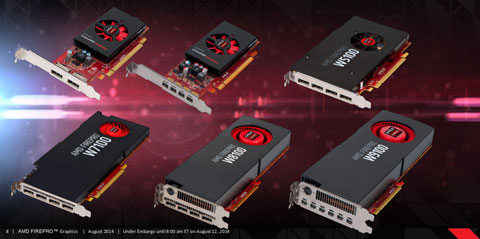
Today at Siggraph, AMD unveiled four new cards to complete its next generation family of professional FirePro GPUs based on the Graphics Core Next (GCN) architecture. The company also unveiled plans to push Mantle, its GCN-optimised graphics API, into the professional 3D space.
In terms of cards, the entry-level AMD FirePro W2100 and W4100, plus the mid-range AMD FirePro W5100 and W7100 join the high-end AMD FirePro W8100 and W9100 that were launched earlier this year. Prices have not yet been announced but should be in the same ball park as AMD’s previous generation FirePro GPUs we are told.
The big story is that these cards are brimming with on-board memory; double that of the previous generation.
Even the entry-level FirePro W2100 comes with 2GB, which should allow CAD users to load up all but the biggest models into GPU memory. Then, in the so-called mid-range, the FirePro W7100 takes things up to a whopping 8GB.
While it’s hard to imagine any CAD-centric graphics workflows using anywhere near this amount of GPU memory, 8GB does offer serious potential for GPU compute and also adds in a good level of future proofing.
The new cards: from the ground up
The entry-level AMD FirePro W2100, a replacement for the ageing FirePro V3900, is being touted to large engineering firms who want to kit out 100s or 1,000s of engineers with professional grade GPUs.
AMD is pitching the card as a cost effective alternative to integrated Intel graphics and, with a claimed performance improvement of up to 67% over the FirePro V3900, plus certifications for all the major 3D CAD tools, sees it as an entry-level option for users of Inventor, SolidWorks, NX, Creo, Catia and others.
The low profile card has 2GB of onboard memory and support for 4K displays. It has two DisplayPort 1.2 outputs.

AMD calls the 2GB FirePro W4100 a new class of professional GPU – ‘a mid-range CAD card with an entry-level price’. Pricing is not yet announced, but we expect it will be around the $200 mark.
Like the FirePro W2100, the W4100 is also a low profile card so it will fit into a small form factor workstation chassis. AMD has yet to announce which workstation manufacturers will be taking it up, but it could be an interesting proposition for this sector, which has historically been very limited in its entry-level GPU options.
The W4100 can support up to four 4K displays and features four outputs (mini DisplayPort rather than DisplayPort, presumably to fit onto the low profile card).
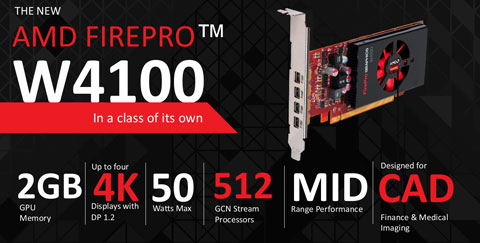
The AMD FirePro W5100 is the new mid-range workhorse CAD card which, boasts 4GB of on board memory, a huge amount for most CAD workflows.
With 1.4TFLOPS of single precision performance it also has potential for GPU compute and should do a fairly decent job of accelerating OpenCL-based ray trace renderers, such a V-RAY RT. It can support up to four 4K displays with DisplayPort 1.2.
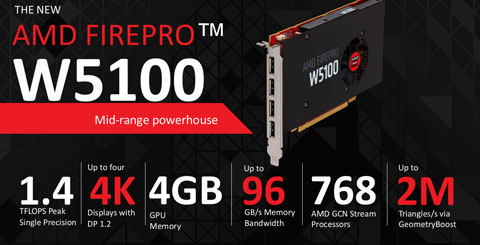
AMD calls the FirePro W7100 ‘the ultimate engineering and media and entertainment solution’. It features a whopping 8GB of on-board memory, double that of the W7000, which not only means it can handle giant graphics datasets, but makes it a serious contender for handling complex, single precision, OpenCL compute workloads.
At time of writing AMD hadn’t nailed down the single precision performance figures of the W7100 but, with its predecessor the W7000 delivering 2.4 TFLOPs, we expect it to be in the order of 3 TFLOPs. It can also support up to four 4K displays with DisplayPort 1.2.
It is due a little later than the other cards, which will ship in September, but will still be available this year.
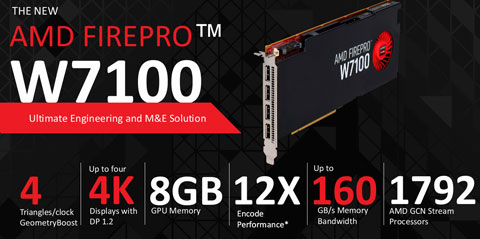
Graphics and compute
Ever since AMD introduced its Graphics Core Next (GCN) architecture it has been trying to get the message out there that AMD FirePro is not just for graphics anymore; it also does compute – and can handle both at the same time on a single GPU. This is in contrast to Nvidia’s multi GPU approach where one GPU is dedicated for graphics and another (or others) are used for compute.
AMD took a little while to properly implement this into its drivers and the tests we did back in Sept 2012 showed it still had work to do.
However, the good news is that it now works – and we’ve verified that it does so very well.
Set a complex ray trace render going in V-RAY RT, which uses 100% of the GPU’s resources, and your 3D CAD model will still respond instantly when you try to move it about on screen. This is not only when using a product like SolidWorks, which puts relatively low graphics demands on the GPU, but even in Lumiscaphe P3D, a high-end design viz application which really taxes the GPU. We’ll share more details on this in the coming weeks.
The problem – at least in the product development arena – continues to be a lack of application support. AMD backs the ‘open’ OpenCL standard, which suffers from slow, committee driven, development, and it has taken a while for software developers to come on board. AMD says the release of the much more mature OpenCL 2.0 later this year will change this.
In the product development space key applications that currently support OpenCL include V-RAY RT from Chaos Group, Simulia Abaqus, and NX Nastran.
While GPU compute is theoretically possible on all the new FirePro cards, the W2100 and W4100 lack the raw power to make them serious options.
Single precision applications, such as ray trace rendering, should run pretty well on the AMD FirePro W5100 or W7100, but you’ll probably need the FirePro W8100 or W9100 if you’re really serious about GPU compute – or want to accelerate double precision applications, such as CAE solvers. Multiple GPUs can also be used in a single machine, which are sometimes branded as AMD FirePro Ultra Workstations.
AMD’s focus on supporting graphics and compute concurrently on a single GPU delivers an interesting conundrum for product development professionals.
If it wasn’t hard enough finding the best GPU to match your 3D graphics workflow – today and into the future – choosing a GPU to also match GPU compute workflows that may or may not materialize in the future throws up a whole new challenge. Our best advice it to think about the ‘now’ and keep a close eye on how OpenCL touches your application stack later. You can always buy an additional FirePro GPU in the future.
Mantle
In the last few weeks AMD has started to make some noise about pushing Mantle into the professional space. Mantle is a graphics API developed by AMD that offers an alternative to the established OpenGL and DirectX APIs that are used by virtually all 3D games and CAD applications. For fear of preaching to the converted, on a base level a graphics API allows the graphics card driver to communicate with a 3D application.
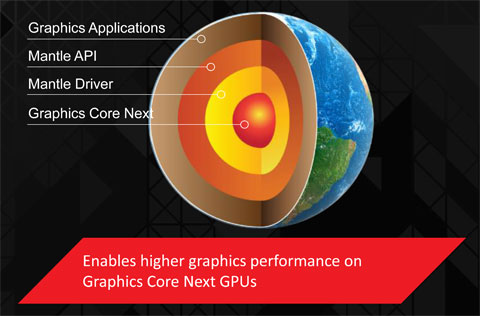
But why do we need another one? As Mantle is brand new, and optimised for AMD’s GCN architecture, it is designed to be faster and more efficient than OpenGL or DirectX. And, according to this interesting report on Tom’s Hardware, it has the potential to increase performance on systems with slower multi-core host processors.
AMD has initially pushed Mantle in the 3D games sector, a market where it has excellent penetration in gaming PCs and consoles. However, the fact that it is turning its attention to professional applications could be big news.
With DirectX and OpenGL, graphics performance in 3D CAD software is almost always dictated by the speed of the CPU – that’s why 3D performance ramps up with the GHz of the CPU, rather than its cores. Mantle, on the other hand, is designed from the ground up to work with multi-core CPUs, so performance should also rise as you add more cores.
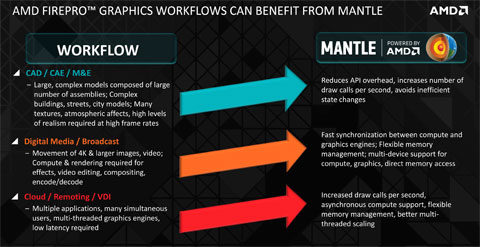
If AMD manages to bring 3D CAD software developers on board with Mantle it could deliver a step change in 3D performance. However, because the API is optimised for AMD’s GCN architecture and will work best on AMD FirePro GPUs, would CAD software developers really back an AMD technology in a market that is still dominated by Nvidia Quadro?
One could argue that, a) it’s not unheard of for 3D software to support multiple graphics APIs so Mantle could potentially be made available alongside OpenGL and b) if your CAD software is in the cloud, with only pixels being streamed to the desktop, it really doesn’t matter what GPU designers and engineers are using on the desktop.
We look forward to seeing how this develops.
Meanwhile, at Siggraph today (and tomorrow) AMD’s Richard Huddy will be talking about Mantle for advanced 3D rendering in the professional CAD, media and scientific markets. Find out more about his talks here.
We are hoping to get our hands on the new AMD FirePro boards soon so keep an eye on develop3d.com if you want to know how the new FirePro W2100, W4100, W5100 and W7100 perform inside SolidWorks and PTC Creo.
Nvidia unveils new Quadro GPUs
Nvidia has also launched a new family of professional GPUs, based on its Kepler and Maxwell architecture. Read our review of the new Quadro K420, K620, K2200, K4200 and K5200, including hands on testing in SolidWorks and PTC Creo.







